Britain’s Record-Breaking Streamlined Express
FAMOUS TRAINS - 15
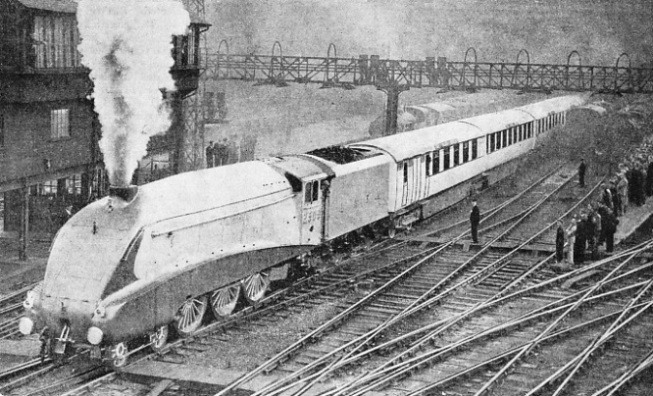
BEGINNING THE RUN. On September 27, 1935, the new LNER streamlined express, the “Silver Jubilee”, undertook a demonstration run between King’s Cross and Grantham, Lincolnshire. On the journey the train created four world’s records, and twice attained a maximum speed of 112½ miles and hour. The picture shows the “Silver Jubilee” leaving King’s Cross Station.
SEPTEMBER 30, 1935, was a great day in British railway history. For it witnessed the entry into regular service of the first ultra-high-speed train in Great Britain. Numerous other British expresses have been timed at high speeds over parts of their daily journeys, the well-known “Cheltenham Flyer” of the Great Western Railway, for example, being booked to cover the Swindon-Paddington stretch of its daily run at 71.4 miles an hour. But none of these, with the exception of the Great Western “Bristolian”, has claimed a mile-a-minute average from end to end of its daily run. Further, all the previous high-speed bookings have been made with ordinary locomotives and ordinary stock.
The “Silver Jubilee” flyer of the LNER strikes a new note altogether. In the first place, it is booked to cover 536.6 miles every day - from Newcastle to London and back - at an inclusive average speed of 67.1 miles an hour. A world's record is created by the fact that a run of over 200 miles in length - between King's Cross and Darlington, the only intermediate stop - is made twice every day at over seventy miles an hour from start to stop. The distance between these points is 232.3 miles, and the booked speed of 70.4 miles an hour includes the severe slowings through Peterborough, Selby, and York, and minor slacks elsewhere. In the second place, a new train - locomotive and coaches - has been built. The train is streamlined from tip to tail.
A preliminary experiment, to prove the feasibility, of this timing, was made on March 5, 1935, over the London-Newcastle course. It was on this occasion that the LNER 4-6-2 Locomotive “Papyrus”, without any special preparation, achieved the astonishing feat of maintaining an average speed of 80 miles an hour over 300 miles of track in one single day's round, and touched the maximum rate of 108 miles an hour in descending the bank from Stoke Summit to Peterborough. Thus it was made clear - for time was gained on the provisional four hours' schedule in either direction - that a daily time of four hours could be maintained in regular service between London and Tyneside.
But to make assurance doubly sure, and to impose less strain upon the locomotives on this onerous duty, it was decided to design a modified type of “Pacific” locomotive specifically, for the new service, and to make the fullest possible use of streamlining in lessening air resistance at high speeds. It has been proved that increase in speed from 60 to 70 miles an hour increases head resistance by fifty per cent, and although this forms only a part of the resistances to be overcome, it is by no means negligible. Recesses and projections on exterior coach surfaces, and, in particular, the gaps between coach-ends, also considerably increase the air resistance at high speed. The decision was, therefore, reached to streamline the train as well.
Four streamlined locomotives, of which No. 2509, “Silver Link”, is the first, were ordered to be built. So far as concerns their internal arrangement, they follow fairly closely the design of the existing “Pacifics”, for their duties will take them on the ordinary express workings between London and Newcastle, as well as on the “Silver Jubilee” express. The working pressure, however, is increased from 220 to 250 lb per sq in, and the cylinders are reduced from 19 to 18½ in in diameter, as compared with the previous high-pressure “Pacifics” of the “A3” series. Further, the firebox has been enlarged at the front end to form a “combustion chamber” adjacent to the tube-plate.
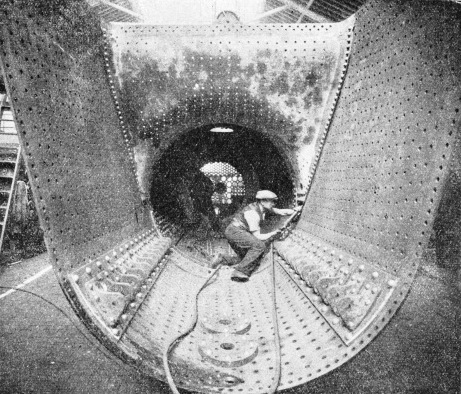
THE OUTER FIREBOX of the new “Class A4” 4-6-2 express locomotive which hauled the “Silver Jubilee”. The total heating surface of the engine is 3,325 sq ft, of which the firebox contributes 230 sq ft. To the rows of castings on either side are attached the links joining the inner to the outer firebox. The two disks in the foreground are the seatings for the safety-valve. The picture shows the outer firebox inverted, as seen when looking towards the front of the boiler.
The leading dimensions of the new “class A4” 4-6-2’s are as under:
Cylinders (3)
Diameter.. .. .. .. .. 18½in.
Stroke . .. .. .. .. .. 26 in.
Heating Surface -
Tubes and Flues .. .. .. 2,345 sq ft.
Firebox .. .. .. .. .. .. 230 sq ft.
Superheater .. .. .. .. 750 sq ft.
Total .. .. .. .. .. .. .. 3,325 sq ft.
Firegrate area .. .. .. .. .. .. 41¼ sq ft.
Tractive effort (at 85 per cent working
pressure) .. .. 35,455 lb.
Working pressure, per sq in .. .. .. 250 lb.
Adhesion weight .. .. .. 66 tons.
Engine weight (in working order) .. .. .. 103 tons.
Tender coal capacity .. .. .. 8 tons.
Tender water capacity .. .. .. 5,000 gallons.
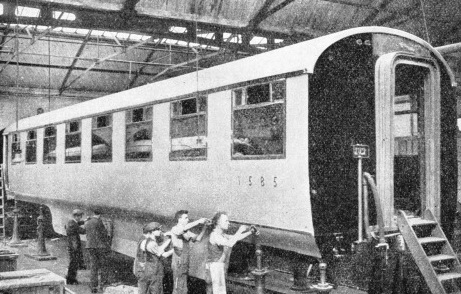
SPECIAL COACHES were built for the “Silver Jubilee”. Streamlining of the train was achieved by linking coach with coach by panels of aluminium-finished rubber sheeting. Externally the coach bodies are panelled with steel sheets which, in their turn, are covered with aluminium-finished “Rexine”. Also, between the bogies of each vehicle there is a skirting reaching to within 10 in of the rail level.
Among novel features of the engine equipment are seats for the crew, with backs, facing towards the front cab windows, a Flaman speed indicator, and a pyrometer to reveal the temperature of the superheated steam. But the most remarkable feature of the design, of course, is the streamlining, which has been carried out with great care. From the buffer beam a casing, across the width of the engine, rises in a beautiful curve to the top level of the boiler, and merges at the rear end into the wedge-fronted cab. The cab roof is prolonged over the front of the tender, with a flexible connexion between, so that the engine-crew is completely enclosed. A lower casing on either side of the engine covers the cylinders, and sweeps back to the cab in a more gradual curve, or the type known as an “aerofoil”. The front end of the locomotive thus resembles a gigantic wedge cutting through the atmosphere.
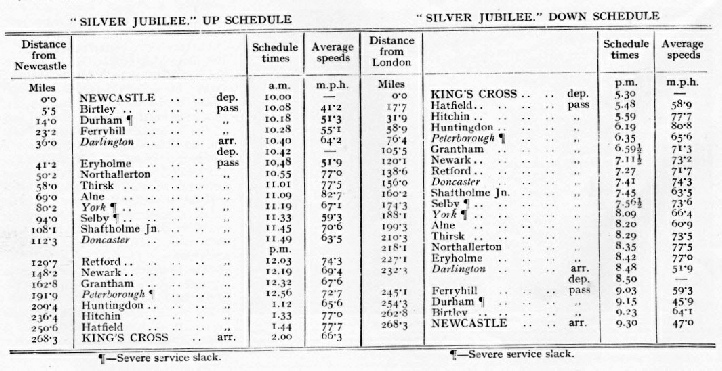
The wedge is horizontal in shape, as this method of streamlining causes a strong up-current of displaced air when the engine is in motion, which tends to lift the exhaust steam from the chimney high above the cab. Horizontal wedge action is much preferable to a vertical wedge type of streamlining, such as that adopted in former days by the PLM Railway of France.
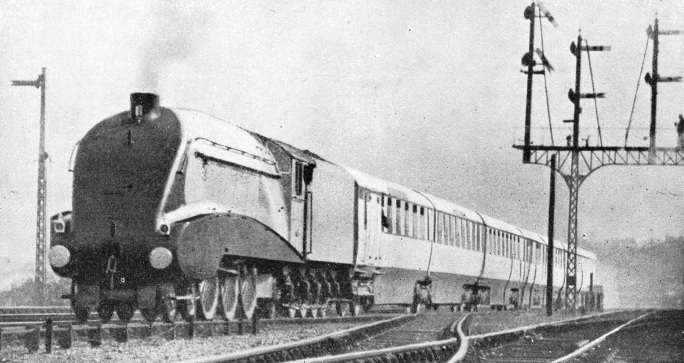
TWENTY-FIVE MILES AT AN AVERAGE OF 107½ MILES AN HOUR was one feature of the amazing performance of the “Silver Jubilee” on the experimental run. The engine hauled a train of seven vehicles which had a gross weight of 230 tons.
The defect of the vertical wedge type is that at high speed laterally displaced air may seriously affect trains running on the adjacent road in the opposite direction. A distinctive effect has been obtained by the three shades of grey in which “Silver Link” has been finished, instead of the normal green. Similarly, in place, of the normal LNER varnished teak for the coaches, the whole train has been finished in grey with chromium-plated fittings, so that the appearance of the “Silver Jubilee” express, grey and silver from end to end, is most striking. The train consists of seven coaches, in three articulated sets. In the middle is a triplet restaurant car set, with kitchen car in the centre, flanked by open first-class and third-class cars. At the north end is a twin third-class and brake set with twelve third-class compartments seating seventy-two passengers, and at the south end a twin first-class and brake set, with eight compartments seating thirty-two, and an open section seating eighteen passengers. With the twenty-eight seats in the first-class restaurant car, and the forty-eight seats in the third-class car, the total seating in the train is 198 passengers. The total tare weight is 220 tons.
Some beautiful new schemes of decoration have been introduced inside the train, and the passenger accommodation is the last word in comfort. A novelty in the first-class section is that all the lighting, except the table lamps in the restaurant cars, is with tubular lamps. Australian maple panelling, “rexine” in soft shades of colour, silver and blue silk curtains, mirrors, loose cushions, and specially sprung seats all play their part in the equipment of the first-class coaches. The third class is equally notable in its comfort and modernity.
In the kitchen all the cooking, as is now customary on the LNER, is carried out electrically, and weight has been saved by using welded steel for the stoves instead of cast iron. The fittings include an automatic electric refrigerator, an automatic water-boiler, and other up-to-date electrical details. Another use for electricity in the train is in the ir-conditioning plant, which forces fresh filtered air, cold or warm according to season, into the compartment at a predetermined temperature.
The streamlining of the train has been carried out by linking coach to coach with panels of aluminium-finished rubber sheeting, which, of course, is flexible, and “gives” when the train rounds a curve. Between the bogies of each vehicle, also, there is a skirting reaching down to within ten inches of rail level. Externally, the coach bodies are panelled with steel sheets, which in their turn are covered with aluminium-finished “Rexine”.
Of chief interest, of course, is the schedule of the new service, which is as set out in the accompanying tables. These show the passing times at all important points intermediately, and the booked speeds between each.
It will be seen from the tables that two sections of the journey - from Thirsk to Alne coming south and from Hitchin to Huntingdon going north - are booked to be covered at speeds of over eighty miles an hour. But the general intention is to avoid the necessity for excessive downhill speed by booking the train over certain of the uphill lengths at speeds hitherto unheard-of up such gradients. What is demanded of the express locomotives will be best realized by this brief survey of the route.
Out of King’s Cross the line rises, almost directly off the platform end, at between 1 in 105 and 1 in 110 through two tunnels for a half to Holloway. Following a short level section, the rise is resumed, for eight miles continuously, at 1 in 200 from Wood Green, until the crest of the “Northern Heights” is breasted at Potters Bar. After a gentle descent past Hatfield to mile-post 18½, where the Lea is crossed, the climb is resumed to the summit at mile-post 23½. In view of the stiff initial ascent to Potters Bar, the demand on the locomotive made by the schedule of 18 minutes over the 17.7 miles to Hatfield will be considerable. After Knebworth there comes the finest racing-ground on the down journey. For the next fifty miles, until the approach to Peterborough, everything is in favour of the engine, with the exception of the short rise for three miles at 1 in 200 beyond Huntingdon. For six miles from Stevenage onwards through Hitchin the descent is as steep as 1 in 200. It is from Hitchin to Huntingdon, as previously mentioned, that the “Silver Jubilee” is booked at an average speed of 80.8 miles an hour; but the far more notable fact is that in the reverse direction, against the same grade, the scheduled speed of the train is no less than 77 miles an hour.
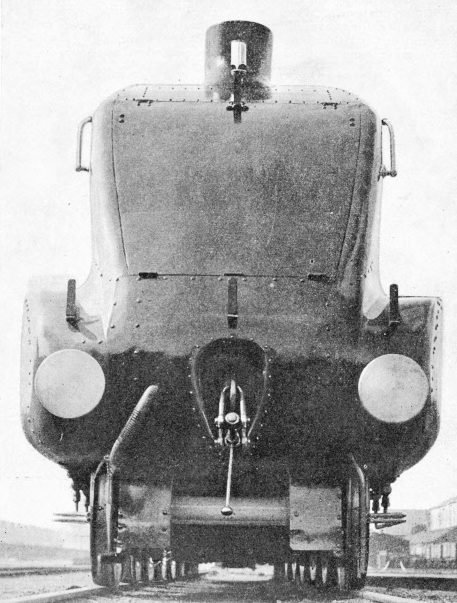
IN REGULAR SERVICE. A head-on view of “Silver Link” the engine built to haul the “Silver Jubilee” express. The train inaugurated a daily express service from Newcastle to London and back. The daily 536.6 miles are scheduled to be covered at a speed of 67.1 miles an hour. The section of the journey between King’s Cross and Darlington, 232.3 miles, is booked to be covered twice daily at 70.4 miles an hour.
From Peterborough to Tallington there are eight and a half miles of level, but the next stretch of thirty miles has in the middle of it Stoke Summit, exactly one hundred miles from King’s Cross, and the highest point anywhere on the line between London and Newcastle. It was in descending from Stoke to Essendine, down the 1 in 178 and 1 in 200, which extend for nine miles, that the engine “Papyrus” touched 108 miles an hour in march, 1935. Yet a study of the schedule reveals that the down “Silver Jubilee” has to maintain an average of 71.3 miles an hour from Peterborough to Grantham, including the whole of the climb to Stoke. Indeed, the northbound flyer is allowed only half a minute more than the southbound over this length. From Stoke northwards, because of curves between there and Grantham, and a slight slowing required through the latter station, high downhill speeds are not practicable until Grantham has been passed.
The section from Newark to Doncaster is of an undulating description, with two minor “summits”. Of these the first - Markham - is reached after eight level miles across the Trent Valley, followed by six miles of climbing, partly at 1 in 200; then there is a drop of three miles at 1 in 200 and 1 in 178 almost to Retford. The second is Piper's Wood, 149½ miles from King's Cross, between Scrooby - the home of the Pilgrim Fathers - and Rossington, with approaches of three miles or slightly less at 1 in 198 from either side.
From Doncaster for the next seventy-six miles the course of the “Silver Jubilee” is virtually level, but unfortunately, its possibilities of sustained speed are interrupted by two severe speed reductions, one over the swing bridge at Selby, and the other through the yards and the station at York, where the line is very sharply curved. Across the Great Plain of York between there and Darlington, full use is made of what has always been recognized as a high-speed stretch, and an average of 79.5 miles an hour is booked in the southbound direction over the 27.8 miles from Eryholme to Alne.
The final stretch of thirty-six miles between Darlington and Newcastle is not so well suited to high speed as the remainder. Colliery workings under the line compel a severe reduction of speed through Durham, and lesser slowings past Browney Colliery, south of Durham, and elsewhere, and there are some gradients which, if short, are steep, particularly in the 1 in 150 ascent, past Chester-le-Street, and the 1 in 101 up which the southbound train has to recover speed after slowing through Durham. This is why the “Silver Jubilee” is allowed as much as forty minutes in either direction for the run of thirty-six miles between Darlington and Newcastle. This schedule is for the present provisional, and may be altered intermediately as experience of the running dictates.
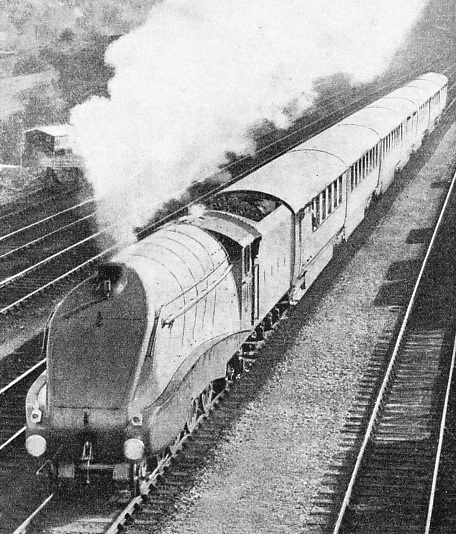
OVER SEVENTY MILES AN HOUR. A remarkable photograph of the “Silver Jubilee” climbing the 1 in 200 gradient past New Barnet, some nine miles out of King’s Cross, at a speed of nearly 75 miles an hour during the Experimental run. About forty-three miles of the journey to Grantham were covered at an average speed of 100 miles an hour.
The ability of “Silver Link” - the first engine of the new class - to travel at the requisite speed was demonstrated in an astonishing fashion at the trial trip which was made on September 27, 1935, three days before the introduction of the new service. Several world's railway records were broken once the train had got into speed. After mounting the initial incline to Holloway, the engine reached 70 miles an hour on the short level stretch to Wood Green, and slowly but steadily accelerated up the long 1 in 200 to Potter's Bar until the summit was breasted at 75 miles an hour. Then the “Silver Jubilee” fairly flew. A speed of 98 miles an hour was attained as the Lea was crossed beyond Hatfield, followed by 88 miles over the summit level near Knebworth, and 95 miles at Langley Troughs. Then the long descent to Huntingdon began. At mile post 30 the magic “hundred” line was crossed.
For the next twenty-five miles the speed never once fell below one hundred miles an hour, and twice rose to 112 - near Arlesey and between Biggleswade and Sandy. This stretch of twenty-five miles was covered at an average rate of 107.5 miles an hour, and formed part of a total distance of forty-three miles covered at the one hundred average. No such figures have been previously known on rails, whether with steam, Diesel, or electric propulsion. It is only in the single particular of the maximum speed attained that the “Silver Jubilee” has to acknowledge a superior, for the new German streamlined 4-6-4 express engine touched, on trial with a train of only 196 tons, a momentary maximum of 119½ miles an hour.
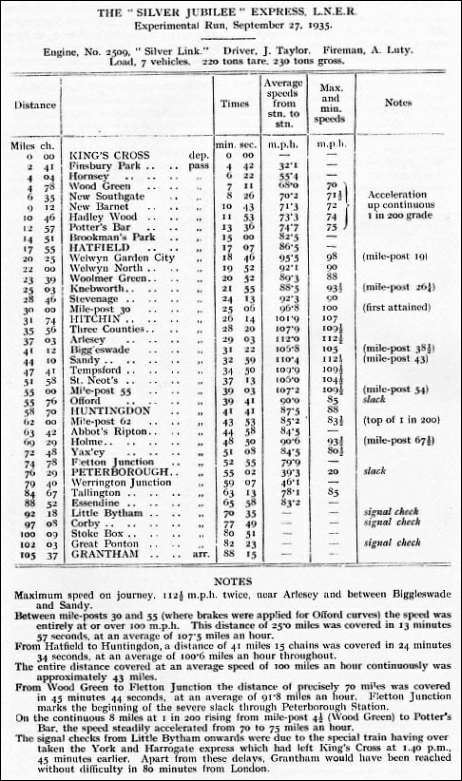 The detailed times and speeds on this wonderful journey, in which the present writer was privileged to participate, are fully set out in the table. Over no fewer than seventy miles continuously up hill and down dale, from Wood Green until the brakes were applied at Fletton Junction for the slowing through Peterborough, the speed averaged 91.8 miles an hour - yet another clear record for steam. Peterborough was passed in 55 minutes 2 seconds from King’s Cross, or ten minutes less than the schedule of the “Silver Jubilee” service, and after but little more than a quarter of the journey had been accomplished. It was small wonder that signal checks soon followed, for “Silver Link” had caught up the regular express which had left London forty-five minutes previously. The trial trip was from London to Grantham and back, and as a performance of a locomotive barely a month old was in every way an amazing demonstration of ability.
The detailed times and speeds on this wonderful journey, in which the present writer was privileged to participate, are fully set out in the table. Over no fewer than seventy miles continuously up hill and down dale, from Wood Green until the brakes were applied at Fletton Junction for the slowing through Peterborough, the speed averaged 91.8 miles an hour - yet another clear record for steam. Peterborough was passed in 55 minutes 2 seconds from King’s Cross, or ten minutes less than the schedule of the “Silver Jubilee” service, and after but little more than a quarter of the journey had been accomplished. It was small wonder that signal checks soon followed, for “Silver Link” had caught up the regular express which had left London forty-five minutes previously. The trial trip was from London to Grantham and back, and as a performance of a locomotive barely a month old was in every way an amazing demonstration of ability.
It is in view of the exceptional speed and comfort provided by the “Silver Jubilee” that a supplementary fare over and above the ordinary ticket is made for its use. The charge is five shillings to first-class and three shillings to third-class passengers. For many years past the only “extra fare” trains in Great Britain have been those composed exclusively of Pullman cars; but the “Silver Jubilee” represents a definite inquiry by the LNER as to whether the British public really does desire facilities of this description.
The gain in time over the best ordinary all-the-year-round service between London and Newcastle is no less than sixty-seven minutes, so that the benefit conferred is considerable. Further justification for the additional charge is found in the new rolling stock which has been built specially for the service, and for the disturbance of other and slower-moving traffic which cannot be avoided when a time-table path has to be found for an ultra-speedy express such as this. The aim of the LNER operating authorities is to keep the train to that path with strict punctuality. The “Silver Jubilee” was put into regular daily service on September 30, 1935, and the “Pacific” locomotive No. 2509 “Silver Link”, although scarcely a month old, and therefore not fully run in, showed itself capable of continuous running involving journeys of over 536 miles a day at average speeds considerably in excess of 70 miles an hour, for the first fortnight continuously, until the second engine “Quicksilver” was ready to share the work, without any trace of mechanical defect. This is in itself a fine testimony to the excellence of both the workmanship and the design.
Since its record-breaking run the locomotive, the first of its class, has shown itself capable of handling the express in accordance with the schedule without recourse to excessive speeds on favourable stretches of line. The general public, as soon as this new service became available to them, were quick to convey their appreciation of the smooth running and comfortable appointments of the train.
Regular running of the “Silver Jubilee” began with the up run from Newcastle to King's Cross on September 30, 1935. This trip shows a striking similarity with that accomplished two days later, on October 2. The express was specially timed at every station between Darlington and King's Cross, and it was found that the difference in passing times between the two runs at any point was never greater than 67 seconds.
This shows how soon the drivers had accustomed themselves to a schedule of so revolutionary a description. More remarkable than this is the fact that, during the first fortnight of running, which comprised ten runs in either direction - the “Silver Jubilee” does not run on Saturdays or Sundays - the express on eight occasions passed Shaftholme Junction, where it moves, just north of Doncaster, from North Eastern Area to Southern Area metals, within half a minute of the booked time of 11.48½ a.m. On the other two runs the' times were 11.47 and 11.49½ a.m. respectively.
During the same fortnight there was one late arrival at Newcastle - on the first down run - and that was to the extent of two minutes only. There was also one late arrival of five minutes at King's Cross because of a signalling failure near Welwyn, which involved the transfer of the “Silver Jubilee” to the slow road for a short distance. There was, by way of balance, one arrival five minutes early at King’s Cross and one four minutes early at Newcastle. The average arrival has been just over a minute early.
Between Newcastle and York are installed sections of automatic signalling, and the distances between signals are comparatively short, so that it is found essential here to restrict the running speed to a little over 70 miles an hour. For this reason it has been necessary slightly to amend the original schedule and to allow 3½ minutes more between York and Darlington, with a corresponding acceleration between King's Cross and York.
It is on the uphill sections of the journey that the full benefit of the locomotive's increased power is shown to be available. On October 2, for example, the speed of “Silver Link”, after passing through Grantham at 76½ miles an hour, fell no lower than 71½ miles an hour at Stoke Summit, with its continuous climb of 1 in 200. Descending from Stoke on the southern slope the running was consistent at a speed of 90 to 94 miles an hour, averaging 90 miles an hour over the stretch of 15.2 miles between Corby and Helpston. Yet another fast climb on this journey was that accomplished at a speed of 74 miles an hour up Abbotts Ripton Bank, which has a similar gradient to that leading to Stoke Summit. The long ascent past Hitchin to Stevenage was ended at 70½ miles an hour.
Diesel propulsion has been avoided with the express intention that British native fuel - coal - shall be used rather than imported fuel oil. And in any event, as compared with the “Flying Hamburger” or the “Flying Cologner”, although the speed of the “Silver Jubilee” is not quite so high, it has double the seating accommodation of either of these German units, in more spacious conditions, and with full restaurant-car accommodation, as compared with merely a cold buffet. The outcome of this enterprising LNER experiment will be watched with considerable interest, and it will be specially informative to see whether or not in climatic conditions such as those of Great Britain a schedule of this description is capable of punctual observance by night as well as by day.
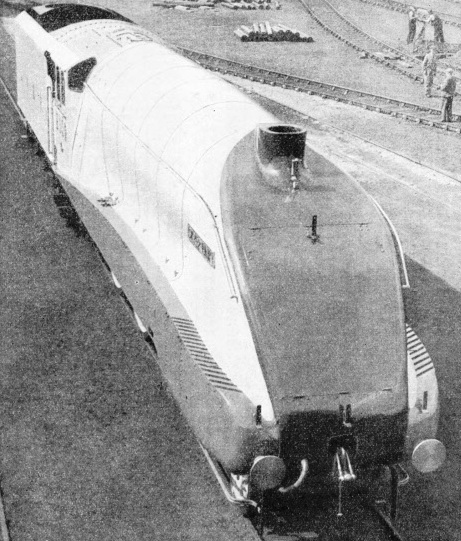
“SILVER LINK”. An unusual view of the new LNER 4-6-2 locomotive. “Silver Link” is the first of four engines of a new class. The leading dimensions are: cylinders (three), 18½ in by 26 in; total heating surface, 3,325 sq ft; working pressure, 250 lb per sq in; weight of engine and tender, 165 tons; and length over the buffers, 70 ft 3½ in.
You can read more on
“The Flying Scotsman”,
“The Great North Road of Steel” and “The Romance of the LNER”
on this website.
You can read more on
“Britain’s Streamlined Expresses” and
“LNER Streamlined Locomotives”
in Wonders of World Engineering










 The detailed times and speeds on this wonderful journey, in which the present writer was privileged to participate, are fully set out in the table. Over no fewer than seventy miles continuously up hill and down dale, from Wood Green until the brakes were applied at Fletton Junction for the slowing through Peterborough, the speed averaged 91.8 miles an hour -
The detailed times and speeds on this wonderful journey, in which the present writer was privileged to participate, are fully set out in the table. Over no fewer than seventy miles continuously up hill and down dale, from Wood Green until the brakes were applied at Fletton Junction for the slowing through Peterborough, the speed averaged 91.8 miles an hour -